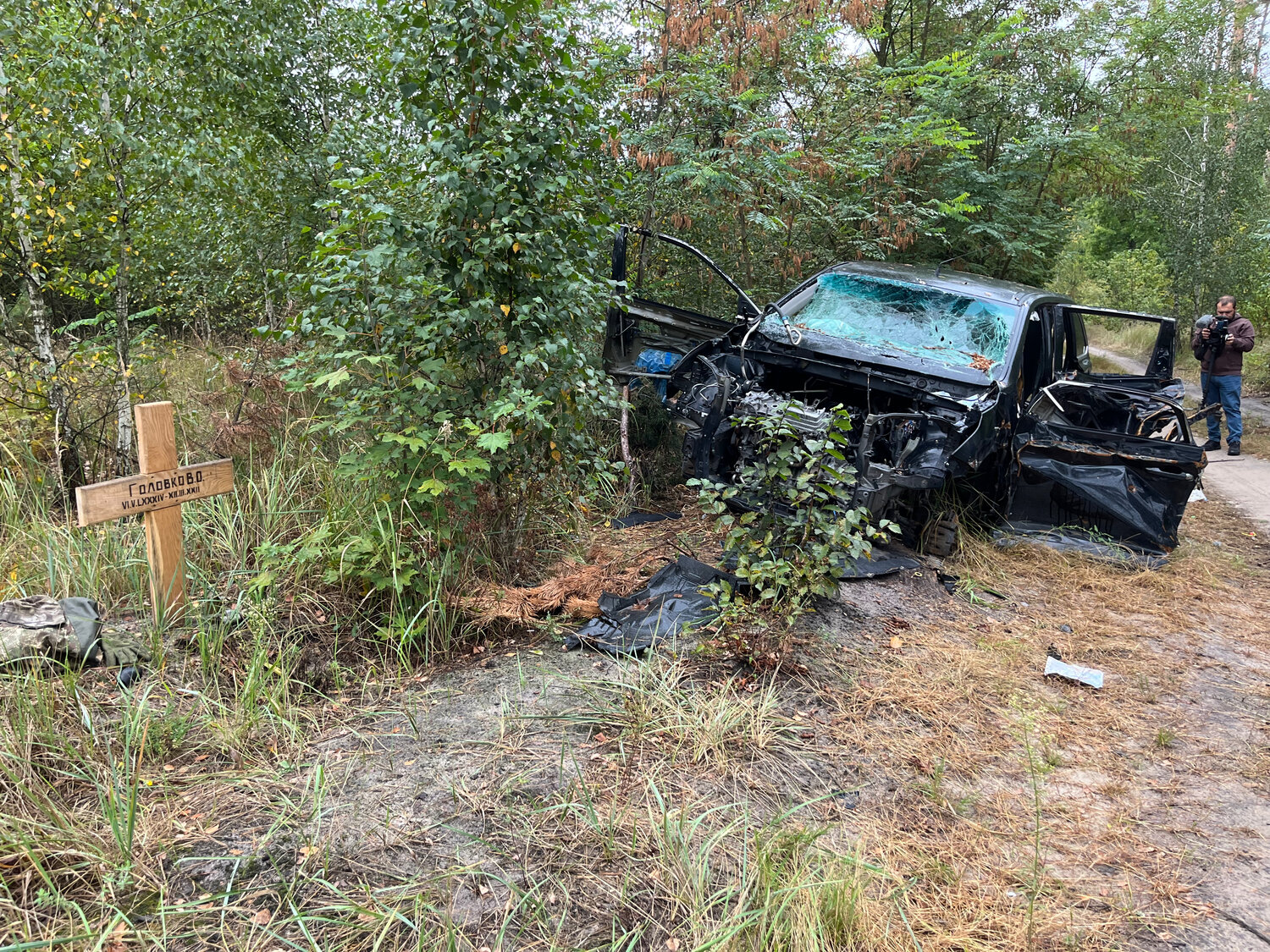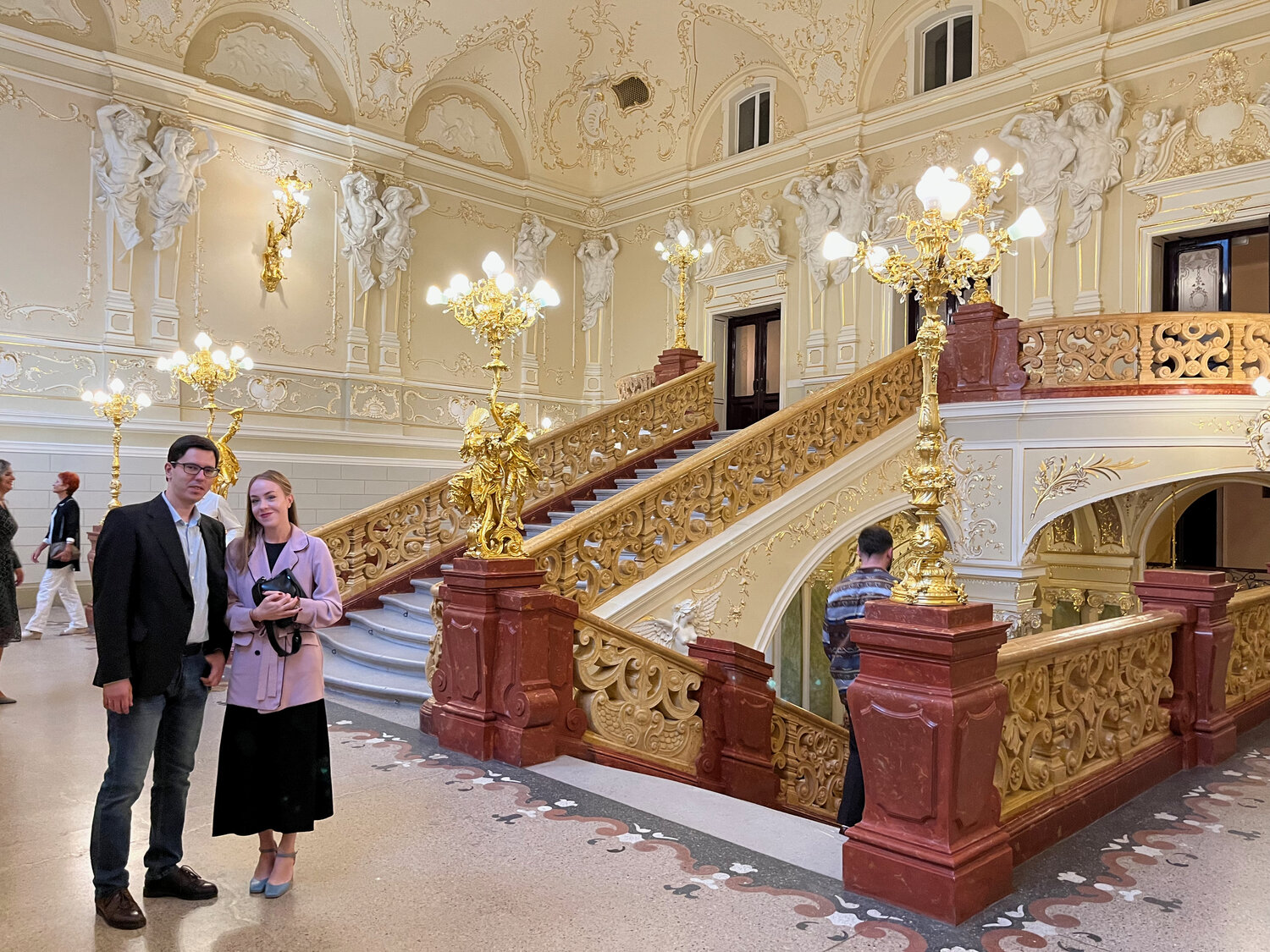Tears, mines and a minyan in Ukraine
Second of three parts
For my second wartime trip to Ukraine, in September 2022, I
flew into Vienna, then took a long bus trip to Lviv, Ukraine, and an overnight train to Odesa.
Near my apartment, a street leading to the Black Sea was barricaded in case the Russians landed.
My guides in Odesa were a young couple, Nataliya Vlasenko and Stanislav Kinka.
Odesa had a large Jewish population from the late 19th century until World War II – at times, 37% of the population – along with many Russians and Greeks. In the city center, there are many apartment buildings built before 1917, usually including a courtyard. Along the shore are the crumbling estates of the wealthy.
At one time, there were three large Jewish cemeteries in Odesa. The first was destroyed in 1939, the second in the 1970s. The still-active third and newest cemetery is mostly overgrown. Nataliya recognized some of the names, including a professor from the university she attended and a grave her mother tended for a Jewish friend.
There were many pogroms against Jews in Odesa. A 1905 pogrom cost up to 1,000 Jewish lives. A large monument marking that pogrom, including the names of many of the victims, has been moved from the second to the third cemetery.
On boarded-up store windows in the center of Odesa, there were hundreds of drawings by children about the war. It was hard not to weep.
My guides suggested I go to the ballet at the recently reopened Odesa National Academic Opera and Ballet Theatre, one of the main tourist sites. Only a few people were allowed in because of the need to get to a bomb shelter during an air-raid alert.
One piece was set to Ravel’s “Bolero.” The costumes were black and red, as if at a bullfight. Most of the audience was taking pictures – of one another – to mark the occasion.
Traveling to Kyiv, I visited Moschen and Hostomel’ with Taras Lazer, a professor of Italian and a scriptwriter. Taras edited the script for “Carol of the Bells,” a 2022 movie. In Moschen, we drove through a forest where many of the road signs read, “Mined, don’t go!”
Dmytro Burko, a farmer, recounted, “I was blown out of a window in my house and over a parked car. I landed on my feet and didn’t realize I had a concussion for a week.”
Next to the Hostomel’ airport, several abandoned 10-story apartment buildings were heavily damaged, as were rows of cars.
I took an overnight train from Kyiv to Khmelnytsky. Arriving early, I begged a few Ukrainian hryvnia (1 UAH equals 3 cents) to pay the $1 fee for the first-class waiting room. A puzzled man obliged.
On the way to Zhmerynka, the origin of Fall River’s Horvitz family, my guide, Viktor Yedynak, suggested a stop in Medzhybizh. There, we saw the recreated shul of the Baal Shem Tov, which was quite humble.
Zhmerynka was a mishmash, with many old buildings. New or old, many of the buildings were rundown. The large Jewish cemetery was very overgrown.
We then headed to Mohilev-Podolski in search of the roots of Rhode Island’s Parness family. Moldova was just across the Dniester River. This area was part of Romania between the world wars. There was a Holocaust memorial in the center of town, and many stores and pre-WWII buildings. The synagogue was closed, but the hairdresser across the street said, “Come back after 5 p.m. There is always someone there.”
We also visited a large, well-preserved Jewish cemetery on a high hill overlooking the city. The scenery is reminiscent of Vermont.
When we returned to the synagogue, a few men arrived for evening minyan. Afterwards, I joined them to celebrate Boris’ birthday with a l’chaim and plenty of food.
Driving north along the river border, we saw abandoned homes next to well-kept ones and soldiers’ graveside funerals.
At a bend in the river, we visited the Jewish cemetery in Sokyriany. A new section had a fresh grave. There were two overgrown older sections.
As we left, three people walked toward us. A woman, accompanied by her sister and brother-in-law, was coming to say prayers at her husband’s grave on the first anniversary of his death. Her husband had been the last Jew in the village.
The widow’s sister recited prayers from an Orthodox Christian prayer book. The widow, who was not Jewish, read Jewish prayers in Ukrainian, then I recited Kaddish.
At their insistence, I accepted a bag that included a fresh loaf of bread, fruit, candy and a bottle of water. Then they got into our car to show us the locations of Sokyriany’s six synagogues.
I ended my visit to Ukraine in Lviv. Many of the buildings in the center are from the 19th and early 20th centuries. It is a wonderful city for walking and for meeting over coffee. I met a Jewish activist, Nataliya Tolok. Nata is the head of Hillel Lviv, which organizes activities for young adults, many of them refugees.
In Lviv, I enjoyed Verdi’s “Rigoletto” in Italian. As I walked towards the Lviv Theatre of Opera and Ballet during a light rain, an accordionist led 20 people in singing Ukrainian songs. They sang through tears.
The next day I returned to Vienna, where I did some sightseeing without having to worry about the next air raid.
Postscript: My most recent visit to Ukraine was in May 2023. The date of my next visit is uncertain. I hope the war will be over, but Ukrainians will still have many years of suffering and misery in their future.
AARON GINSBURG lives in Stoughton, Massachusetts, and blogs at jewishnewport.blogspot.com.











